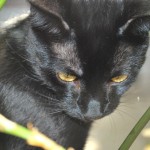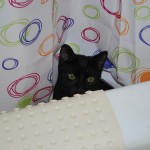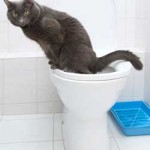Inflammatory Bowel Disease In Cats

IBD or Inflammatory Bowel Disease is defined as an inflammation of the stomach, small intestine, large intestine, and/or the colon. There’s even some suspicion that feline stomatitis may also be a representation of IBD as an extension of the gastro-intestinal tract. IBD is thought to occur from dysregulation of mucosal responses which result in inflammation to intestinal microflora changes and/or dietary antigens.
The symptoms usually include the obvious GI distress of vomiting and/or diarrhea that occurs for at least 3 weeks. But the cat doesn’t have to have diarrhea to raise the red-flag for IBD. It can be something as subtle and not-so-obvious. Such as, a sudden change in litter box habits: like, pooping outside the litter box, or vomiting up fur balls. Yes, fur balls can be an early sign of IBD. Many people think cats upchucking fur balls is a normal thing, but it’s not. Cats digestive system is designed to ingest fur and feathers. So, the next time you step on a cold, wet, fur ball you may want to consider your cat may be having some kind of a motility disorder, especially if it’s occurring frequently.
Before deciding it’s IBD we need to rule out a few other possibilities. Such as:
1. Food allergies or intolerance (Studies have shown that 80% of cats are allergic to fish, beef, and dairy products. And, food sensitivities may account for 16% to 65% of diarrhea cases in cats).
2. Parasites (e.g., Giardiasis, Salmonellosis, Campylobacteriosis, Tritrichomonas foetus infection, Clostridium spp infection).
3. Medications. Adverse side-effects.
4. Plant or toxin intoxications that can lead to vomiting or diarrhea.
5. Endocrine diseases like hyperthyroidism, diabetes mellitus. Or, renal disease, liver disease, FeLV, FIV, coronavirus.
6. Neoplastic growths (Feel around for a mass in small intestines). This is important to consider in long-term chronic cases of IBD.
7. Motility disorder (stomach contractions and the digestion of food is abnormal).
The Role Of Gut Flora
A healthy, balanced microbiome will support the immune system, and by competition, it will help exclude transient pathogens that may come in through the mouth via food. The microbiome will also provide nutritional benefits by way of short chain fatty acids and other metabolic by-products that help to nourish the gut. 99% of normal intestinal microbiota will typically constitute firmicutes, bacteroidetes, actinobacteria, and proteobacteria. Recently, it’s been found that feline microbiota can be modulated by the amount of soluble fibers and macronutrients (carb/protein/fat content) in the diet. The microbiome also has a major impact on gastro-motility and that’s because short-chain fatty acids play an important role in muscular contractions in the stomach.
In 2008, there was a study that looked into whether there was a difference between the gut flora of a cat with IBD vs a cat with a healthy microbiome. And what they found was a large imbalance in intestinal flora. Cats with IBD had a total of 66% of Enterobactericeae spp in the gut, compared to a healthy cat that had less than 0.3%. The healthy gut also showed more variety of bacteria: e.g., streptococcus spp., bacteroides spp., clostridium spp., E.coli, and other bacteria.
The following is a dog study but it is relevant to cats: In 2015, there was another study comparing the bacteria in the feces of dogs that were fed a processed commercial pet food and a raw diet. Researchers were hoping to discredit raw diets by proving the stool would contain high amounts of gram negative pathogens like salmonella, E.coli, etc., thus, presenting a health risk to humans. What they found was the opposite was true:
It was expected that the groups of dogs fed commercial raw diet would have an increase or the presence of enteric pathogenic bacteria as Salmonella spp., Shigella spp., Yersinia spp. and E. coli O 157, however the results showed that the dogs fed commercial raw diet has similar enteric flora, and no pathogenic bacteria was found in the raw group as expected.
Whereas, the stool of the dogs fed an ultra-processed commercial pet food were found to not only contain a number of gram negative pathogens but were much higher than expected (link to study is posted below).
The Role Of Diet & Inflammatory Bowel Disease
Although IBD has been considered idiopathic (unknown etiopathogenesis) there is evidence that suggest processed pet food plays a big role in the disease. In one study, cats were divided into two groups and were either fed a processed wet or dry diet. After five weeks, they discovered a dramatic shift in fecal bacterial communities. Bifidobacteria were not present in either the dry food or wet food group of cats. In this study, fecal Lactobacillus population was much greater in dry-food fed cats. These results demonstrated that short-term dietary exposure to processed dry or wet food leads to large shifts in fecal bacterial populations that can affect the ability for the cat to process macronutrients in the diet. This is one of the reasons you see diarrhea in cats when you suddenly change their diet, it’s because you’re changing the microbiome.
So, what’s in processed pet food that can affect your cats gut flora? Well, there are a number of things. But right now I’ll discus two things: Most commercial pet food contain Maillard by-products: one such by-product is 5-hydroxymethylfurfural which is a palpability enhancer that helps to make your cat addicted to pet food. During the processing procedure of pet food, the Maillard reaction occurs. This is where sugar and amino acids come together under high-heat and create the browning, crispy effect you see on toast. It makes the food look appealing and tasty. In 2014, a study took a look at how much Maillard by-products were present in pet food. They found the content was 129 times higher in dog food, and 40 times higher in cat food, compared to the average intake in human consumption. The thing is nobody knows the long term effect of our pets eating these by-products. But what we do know is that rat studies have shown that 5-hydroxymethylfurfural by-product of thermally processed foods (like French Fries) are carcinogenic. The only problem is they don’t know exactly how much Maillard by-product it takes to cause cancer in humans, or in our pets.
A pet food ingredient possibly linked to IBD is carrageenan. I’ve written about this before and you can find my blog here. But, I’ll summarize: About 80% to 85% of canned pet food contain this ingredient. Carrageenan is a seaweed (Irish moss) that is alkalized in the processing procedure and forms into sulphated polygalactan. It is used as an addictive to thicken, emulsify, and preserve food. Carrageenan is a major cause of gastro-intestinal inflammation in humans. Not only does it cause ulcerations in the GI-tract, but also tumors.
Stress & Inflammatory Bowel Disease
Studies have shown stress is a contributing factor in Cohn’s Disease in humans. Stress signals are received by the brain, triggering transmission by the vagal nerve to the gut. This can have a large impact on pain associated with IBD in humans. In animals, a study observed that stress releases the hormone corticotrophin which reduces intracellular protein which activates interleukins that control bacterial growth in the body. So, if you have increased cortisol then you have reduced proteins and now have decreased control of bacterial growth. Therefore, this is one of the things that can modify the microbiome.
Treatment
The usual conventional treatment for feline IBD is to give drugs. Such as, steroids, like Prednisone or Prednisolone. Also, Metronidazole (Flagyl) which works locally in the GI tract and is rapidly metabolized in the liver. Metronidazole has not been approved by the FDA in use for small animals and is administered off-label. Although Metronidazole can temporarily relieve diarrhea, a single dose can disrupt the microbiome for up to 4 years. It can cause chronic gut issues, weakened immunity, and long-term digestive problems. Then there is Azathoprine, but because of bone marrow suppression it is rarely used. For colititis and large bowel issues there is Sulfasalazine, but is not commonly used in cats. Veterinarians will also administer Cobalamine (B-12) because cats with IBD often have very low Cobalamine levels, especially cats with weight loss.
Is There A Natural Solution For IBD?
Yes, there is.
Probiotics
Probiotics is a blessing to IBD sufferers. I always recommend a broad multi-strain probiotic with a high CFUs. It’s important to check the ingredients as there are brands on the market that contain corn starch and milk proteins which many cats can be sensitive to and this may make things worst.
Probiotics can help reduce pathogenic bacteria and intestinal pH. They also help produce short-chain fatty acids, as well as, lactic acid and acetic acid. Probiotics produce antimicrobials, antivirals, and antibacterial products to fight against bacteria which competes with and/or deplete nutrients, and can occupy binding sites of bacteria.
Herbs
Herbs can be used as a pre-biotic to add fiber to the diet. Such as, marshmallow root, or slippery elm. Marshmallow is a feline friendly herb and can help soothe an irritated gut. What I like to do is add a small amount of dried marshmallow root to some warm water until I get a mushy, mucilage and add it to the food.
Bitter herbs are the key treatment for IBD. They help to stimulate function and motility of the gastro-intestinal tract, increase gastric secretions, normalize digestive function, balance intestinal flora, increase bile secretions, and are antimicrobials.
Carminatives are usually aromatic herbs and spices and can help with flatulence and pain. And, adaptogen and nervine herbs help reduce stress. Withania Somnifera (Ashwagandha) is an adaptogen herb that also has an anti-inflammatory effect on the gut and has been used traditionally in India as a treatment for diarrhea in children.
Berberine herbs are exceptional antimicrobials for the gut and gut dysbiosis. Herbal formulas may also include demulcent, astringent, carminative, antispasmodic, immune support herbal agents.
Fecal Microbiota Transplant
There has been some research in applying fecal microbiota transplant (FMT) to small animals, but very little testing has been done on its effectiveness in cats. That is, until now:
Recent research from the USA found that fecal microbiotas treatments in cats are 77% effective at resolving clinical signs of IBD, and also detected modest but significant changes in the fecal microbiome. See study HERE. Also, please read my blog for more information on Fecal Transplant in animals HERE.
And, let’s not forget homeopathy. I have used homeopathic remedies successfully to help cats with IBD. So, along with a fresh raw food diet, stress reduction, probiotics, homeopathy, and herbs…Yes, there is a natural way to help your cat with IBD.
If you have a cat with IBD and you need help with a diet plan and herbal/homeopathic remedies, I would suggest a consultation.
Further Reading: The role of short-chain fatty acids in the interplay between diet, gut microbiota, and host energy metabolism










